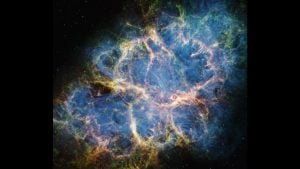

The Crab Nebula, a dazzling cloud of gas and dust leftover from a massive star’s explosion, has long perplexed astronomers. Now, thanks to NASA’s James Webb Space Telescope (JWST), scientists are getting a clearer picture (pun not intended) of this celestial oddity.
Researchers have analyzed the nebula’s composition using JWST’s powerful infrared instruments, MIRI (Mid-Infrared Instrument) and NIRCam (Near-Infrared Camera). Not only the accompanying image and video provide new clues about its history and the type of supernova that created it, they also look stunning!
A supernova remnant with a twist
The Crab Nebula, located 6,500 light-years away in the constellation Taurus, is the result of a core-collapse supernova witnessed on Earth in 1054 CE. However, unlike typical supernova remnants, the Crab Nebula exhibits unusual characteristics, including a low explosion energy and a fast-spinning neutron star at its center.
Previously, these features pointed toward an electron-capture supernova, a rare event triggered by a star with a core deficient in iron. However, Webb’s observations challenge this theory.
“Now the Webb data widen the possible interpretations,” explains Tea Temim, lead author of the study at Princeton University in New Jersey. “The composition of the gas no longer requires an electron-capture explosion, but could also be explained by a weak iron core-collapse supernova.”
JWST’s spectroscopic capabilities allowed the team to measure the abundance ratio of nickel to iron (Ni/Fe) within the Crab Nebula. Their findings revealed a slightly elevated Ni/Fe ratio compared to the Sun, but significantly lower than earlier estimates.
While this revised value aligns somewhat with the electron-capture theory, it also doesn’t exclude the possibility of a low-mass iron core-collapse supernova. Further investigation is needed to definitively distinguish between the two scenarios.
Mapping the Crab Nebula’s dusty secrets
Beyond compositional analysis, Webb peered into the broader environment of the Crab Nebula. Using MIRI, scientists were able to isolate and map the nebula’s dust distribution in unprecedented detail.
“Where dust is seen in the Crab is interesting because it differs from other supernova remnants, like Cassiopeia A and Supernova 1987A,” said Nathan Smith of the Steward Observatory at the University of Arizona and a co-author of the paper. “In those objects, the dust is in the very center. In the Crab, the dust is found in the dense filaments of the outer shell. The Crab Nebula lives up to a tradition in astronomy: The nearest, brightest, and best-studied objects tend to be bizarre.”
This distinct dust distribution further underscores the unique nature of the Crab Nebula.
A step forward in unveiling the Crab Nebula’s past
These JWST observations represent a significant leap forward in understanding the Crab Nebula. The refined data on its composition and dust distribution offer valuable insights into the type of star that exploded and the resulting supernova event.
While the mystery surrounding the Crab Nebula isn’t entirely solved, Webb’s contribution has opened doors for further exploration and answering questions about this celestial marvel’s past.
[Credits: NASA, ESA, CSA, STScI, T. Temim (Princeton University)]







